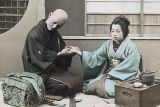Spa Therapies Of Japan
Ki – The Japanese Healing Bowl:

The concepts employed in Japanese medicine are strongly linked with TCM and similarly advocate living in harmony with nature. Qi, or the life force that sustains the body in TCM, is known as ki in Japan, and its manipulation is an essential part of many Japanese healing techniques. TCM’s philosophy can be applied to the understanding of Japanese healing – the Chinese yin-yang theory of balance corresponds to the balance between in and yo in Japan; the network of 12 main meridians and 8 ‘extraordinary channels’ in TCM are the same as those in the Japanese system. Illness is believed to result when there is a disruption of normal processes caused by ki that is in a state of either kyo (deficiency) or jitsu (excess). When ki is deficient, it is said to be more in (yin) in nature; when it is in excess, it is more yo (yang).
Bo-shin (observation diagnosis) and setsu-shin (palpation diagnosis) are the two primary ways a Japanese practitioner determines your state of ki and thereby your state of health. In bo-shin, various visual indicators, including your gait, skin, nails, hair, facial features, and body size and proportions are used. Setsu-shin is a sophisticated diagnostic technique that requires considerable experience and skill. It entails taking your pulse at the wrist, with the practitioner diagnosing your state of health by analysing your pulse patterns, which reveal the patterns of kyo and jitsu in your organs and meridians. It was particularly useful in the past when modesty prevented a patient from disrobing before a physician. Ampuku (abdominal diagnosis), which originated in the early 17th century, is another popular diagnostic technique, and one that is unique to the Japanese. It is based on the premise that different areas of the abdomen correspond to specific organs. Through gentle pressure, a practitioner may detect conditions of kyo or jitsu, and some believe even life expectancy.
Once a practitioner has determined the amount of ki in the different meridians and organs, he is able to determine the root cause of the imbalance and disease, and recommend an appropriate treatment. The primary aim of treatment, whether through acupuncture, massage or herbal therapy, is kyo-jitsu-ho-sha, which means replenishing a deficiency of ki and dispensing excess ki, in order to regain balance.